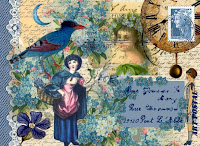After having watched Tagny Duff's performance art piece, "Elephantiasis Ears", in which she wandered around in a mall, naked accept for a pair of huge years hooked up to some kind of audio equipment. This piece stirred up a lot of discussion in the classroom both Tuesday and Thursday when there was a panel discussion in which it was brought up. People expressed diverse reactions to the piece, many of them very critical. I didn't really participate in the discussion on either of those days, even though I had stuff to say...so, I'm going to say that stuff here instead.
Concerns were brought up about the fact that she was naked out in public, and touching people, both of which might make people uncomfortable, and there were some concerns about children possibly seeing the performance, and the effect that this might have.

As to the nakedness; I agree that it likely made some people uncomfortable, and a naked woman wandering around a mall is not something you see everyday--I wouldn't want to dismiss anyone at the mall who was upset at this. I also won't deny that such a sight might trigger some questions from any child that might happen to be in the audience. However, art often makes people uncomfortable, and this very discomfort is what a lot of art is really about. Not only that, but how traumatizing is the site of a naked woman anyway? And if it is traumatizing--how much of that trauma is social constructed, rather than inherent in the nakedness itself? As far as children go, I would be much more concerned about my children (and I am weary of making this statement, since I have none yet) viewing thousands of images of almost-naked, or provocatively dressed women who have been starving themselves or have been digitally altered to be unrealistic--I would be more concerned about them viewing these images and
not asking any questions, than I would about them seeing a real naked woman in a mall, and asking a few questions than I bet wouldn't be too hard to answer if you can be a little creative.
As far as the touching goes, I think it's really important to distinguish between different types of touching; Duff was not grabbing anyone, or touching them in any inappropriate places--in fact, I think in the clip we saw, she was mostly just offering them handshakes, though she did lay her hand on a few people's shoulders. I acknowledge that her being naked would definitely alter this experience for people, and I admit that if I were preforming "Elephantiasis Ears" (and I wish I had the ovaries it took to do something like that) I would probably decide to just stick with the offering of the handshakes and only touch those who extended their hands in return, because it's probably a little scary to be touched by a naked person without your permission--I guess that's where I draw the line. Again, though, she wasn't being violent or sexual about the touching, and I think that's important to note.
Of course, it is true that this being outside of the gallery setting, with the audience (or crowd) unprepared for anything but a shopping trip, and unaware of the nature of the performance makes the situation quite a bit different than one in an art gallery, but I think that's completely the point of the art work, and I don't think Duff would have accomplished what she clearly wanted to accomplish as effectively in the traditional setting. Questions were raised about whether or not this counts as art, or if it is good art. I would just like to contribute to that discussion by saying that in my completely subjective, and insufficiently educated opinion, it is; it seems to me that Tagny Duff was trying to say something about connection, and about social norms, and possibly also about intimacy, and I think she did it very well and it if you disagree with everything else that I have said in this blog post, then you still have to admit that it took guts, and you wish you had guts like that when it came to doing things that are important to you, and maybe you do--in which case, congratulations.
...obviously I should have written my essay on this instead.


